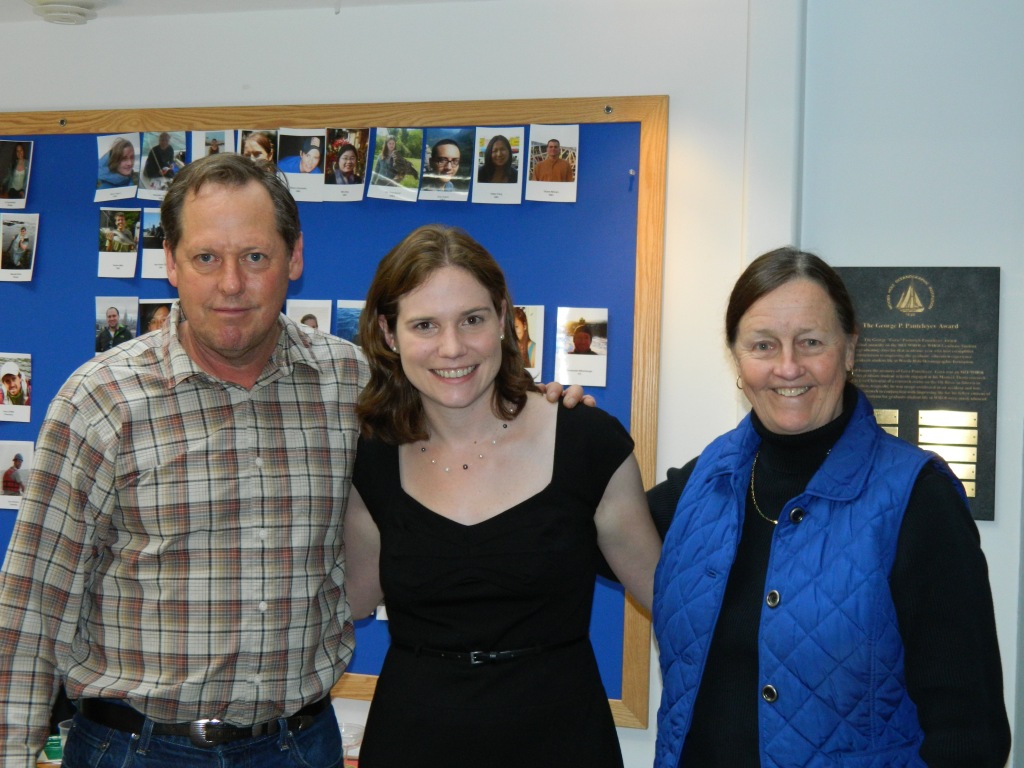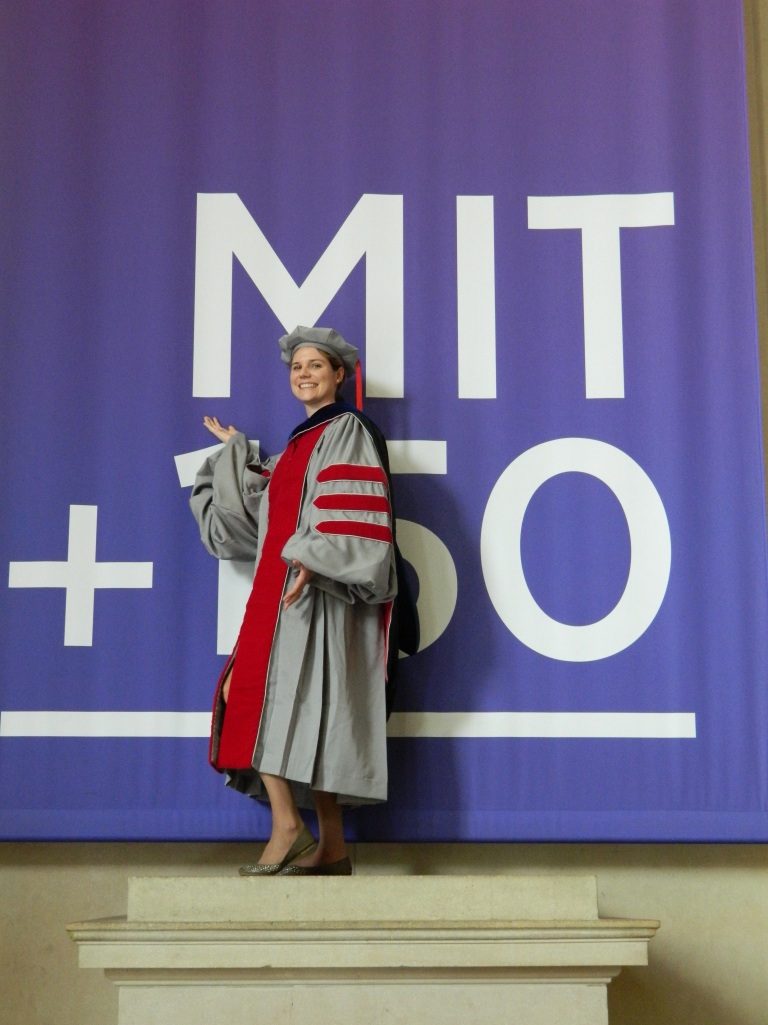
Almost three weeks ago I participated in the doctoral hooding and commencement ceremonies at the Massachusetts Institute of Technology (MIT). During these ceremonies, I received my doctoral hood and my diploma, which I earned for my PhD in Marine Geology, a degree which was jointly awarded by MIT and the Woods Hole Oceanographic Institution (WHOI). During the course of planning for and participating in these ceremonies, I found myself fascinated by the traditions associated with these ceremonies. I found myself particularly fascinated by the doctoral regalia and other forms of academic dress, which are the fancy robes worn by the faculty members and graduates in the ceremonies.
I think I found myself fascinated by the academic dress because the standard dress for students and professors– at least in the geology departments at MIT and WHOI– is fairly casual. Personally, I generally wore shorts, t-shirts, and sandals in the summertime and jeans, t-shirts, sweaters, and sneakers in the wintertime during my time at MIT and WHOI. This sort of clothing is more-or-less what most people in the departments wear. At both institutions, it was not uncommon for me to encounter people in exercise clothes or field clothes or old painting clothes, recently covered in dirt and mud from some rock or core sampling project. Occasionally, I wore fancier clothes. I wore slightly nicer attire (perhaps a skirt or just nicer shoes and a nicer shirt with jeans) for classroom presentations, and I wore full-out “dress attire” (a simple suit or a dress with a nice sweater or jacket) for my qualifying exams, committee meetings, presentations to the trustees, and for my PhD defense. Given the fairly casual attire worn around the geology (and many other) departments, I found it delightful and somewhat humorous to see my classmates and faculty members decked out in elaborate doctoral regalia, complete with fancy velvet and tassles and bright colors.
A few weeks ago, I thought I might do a little research on academic dress and then write up a post on such dress, perhaps with a focus on doctoral regalia. However, after a few minutes of google searching, I found myself overwhelmed with information about academic dress. Academic dress comes in all shapes and sizes and colors, and each country– even each institution– seems to have its own particular set of rules for academic dress. Thus, I think I’ll abandon my pursuit to write a detailed post about academic dress. Instead, I’ll just provide a little bit of basic information about the dress and then will focus this post on the doctoral regalia which I recently wore.
I’d also like to present a call for pictures. I think it would be great to compile a bunch of pictures of people in their academic dress, so if you have a photo of you in your dress, please email it to georneysblog AT gmail with a little bit of information about the dress (perhaps provide the name of the school and the degree and any information about what various parts of the attire might represent). I’ll compile the pictures, and we’ll have an academic dress parade here on Georneys. If you prefer, you’re welcome to post pictures of your academic dress on your own website or blog, and I can just link to your post.
I’ll start the academic dress parade with some pictures of my MIT /WHOI doctoral regalia and a description of the ceremonies in which I participated. MIT has a great webpage here which gives a little bit of history about academic dress in America and then describes the MIT academic dress. My academic dress journey started when I had to make a decision about whether I wanted to buy or rent the doctoral robes. Purchasing the doctoral robes from the official MIT store costs over $700. Renting the doctoral robes from the MIT store is still fairly expensive– about $170– although you are allowed to keep the fancy gray hat with the tassle. You also are allowed to keep your doctoral hood, which is presented to you at the hooding ceremony. Various knock-off MIT doctoral regalia can be purchased or rented for less money. A word of advice about that: DO NOT purchase or rent the knock-offs… or at least make sure you inspect the quality of the knock-offs prior to the ceremony. I saw some terrible looking knock-off robes during the hooding and commencement ceremonies. Some of the cheap knock-off robes started to fall apart during the ceremony– the stripes on the sleeves were actually peeling off in some cases. Although expensive, the official MIT gowns definitely look MUCH better than the knock-offs. Of course, for awhile I contemplated purchasing this $20 Harry Potter costume, which could probably pass as doctoral regalia… and could also be worn with a stylish wand, I suppose.
I contemplating renting verses buying for a few days and then decided to rent my doctoral regalia. While academic dress used to be worn daily (back in the 1700s and 1800s, anyway), these days academic dress is pretty much only worn at fancy ceremonies such as commencement. So, the only time that I might wear my fancy academic regalia in the future would be as a university faculty member participating in graduation and other ceremonies. Several months ago, I decided to leave academia and spend some time working in industry. One day, I may return to academia. However, I don’t see any need for my doctoral regalia in the near future, so I decided to rent the regalia.
I first donned my rented regalia on the morning of Thursday, June 7th. My husband Jackie and I woke up very early– about 5:30 am– so that we could drive from my parents’ house in New Hampshire to the Alewife T-station (subway station) in Boston. We parked the car at Alewife then took the T to the Alewife/Kendall stop, where we visited the MIT COOP to pick up my doctoral regalia. I was worried it might take a long time to pick up the regalia, but the process actually went fairly quickly. We soon headed across campus to the gym, where the doctoral hooding ceremony was going to be held.
As we were walking around outside the gym, a Chinese couple came up to us, and the man said to me, “You are very beautiful. I take a picture?” I was a bit flabbergasted, but I agreed. I ended up taking several pictures with the Chinese man and his wife, who told me (in very broken English) that they were tourists from China and were very excited to be visiting MIT. I’ve encountered many Chinese and other Asian tourists during my years at MIT. Often, the tour groups at MIT are full of Asian tourists. I guess my doctoral robes and I will be shown in some vacation picture slideshows over in China! Being asked to take pictures with the two Chinese tourists reminded me just how special– how beautiful, really– it was to be graduating from MIT. I am very lucky to have had the opportunity to study– and graduate from!– such a world-renowned institution.
Eventually, the Chinese tourists left us alone, and I went inside the gym to line-up. Jackie waited outside to meet my parents, who drove down from New Hampshire a little bit later. After some waiting and some processing, the soon-to-be-doctors made their way into the gym and sat down on the plastic chairs that were lined up. At least, most people sat down on plastic chairs. There were supposed to be 13 chairs in each row, so the ceremony staff members counted out 13 people before starting a new row. However, in the row where I sat there were only 12 chairs because one chair had been taken away to make room for a person in a wheelchair. As we were counted out, my classmates and I tried to protest when 13 people were directed to sit in 12 chairs, but our protests were swiftly dismissed by the stern staff member.
Before we knew it, the procession music had ended, and we were trying to figure out how to sit 13 people in 12 chairs. Fortunately, we were seated by degree, so most of the people sitting in my row were my fellow classmates in the MIT/WHOI Joint Program. Therefore, at least we knew the people to whom we were suddenly a bit too close for comfort. The plastic chairs placed out for the ceremony are not very comfortable to begin with, and they are definitely not comfortable when you are sitting on half of one chair and a quarter of another chair. We giggled and elbowed each other a bit, but otherwise we managed to make ourselves look reasonably presentable for the ceremony despite our 13-people-in-12-chairs situation. At one point, we attempted to steal a chair from a partly-empty row behind us. However, we noticed– just in time– that the chairs were tied together. I imagine we would have caused quite a ruckus had we pulled on the one chair and moved the entire row of chairs. In any case, we survived our seating arrangement, and I managed to enjoy the ceremony despite the uncomfortable seating.
The ceremony was fairly simple. There were a few speeches, and then the names of the 400+ doctoral graduates were read. After a person’s name was read, the person went onto the stage, where he or she received a doctoral hood. Each hood was placed over a student’s head by the chancellor, who was assisted by a representative from the student’s department. My hood was thus placed over my head by the chancellor and by Jim Yoder, who is the Dean of the MIT/WHOI Joint Program. I’ve known Jim for several years, and it was nice to have someone I know investing me with my doctoral hood. If you have any interest, you can watch a video of the hooding ceremony here. I receive my doctoral hood towards the end of the video. On that same website, there are also videos of the next day’s commencement ceremony.
Here’s a picture of me receiving my hood:
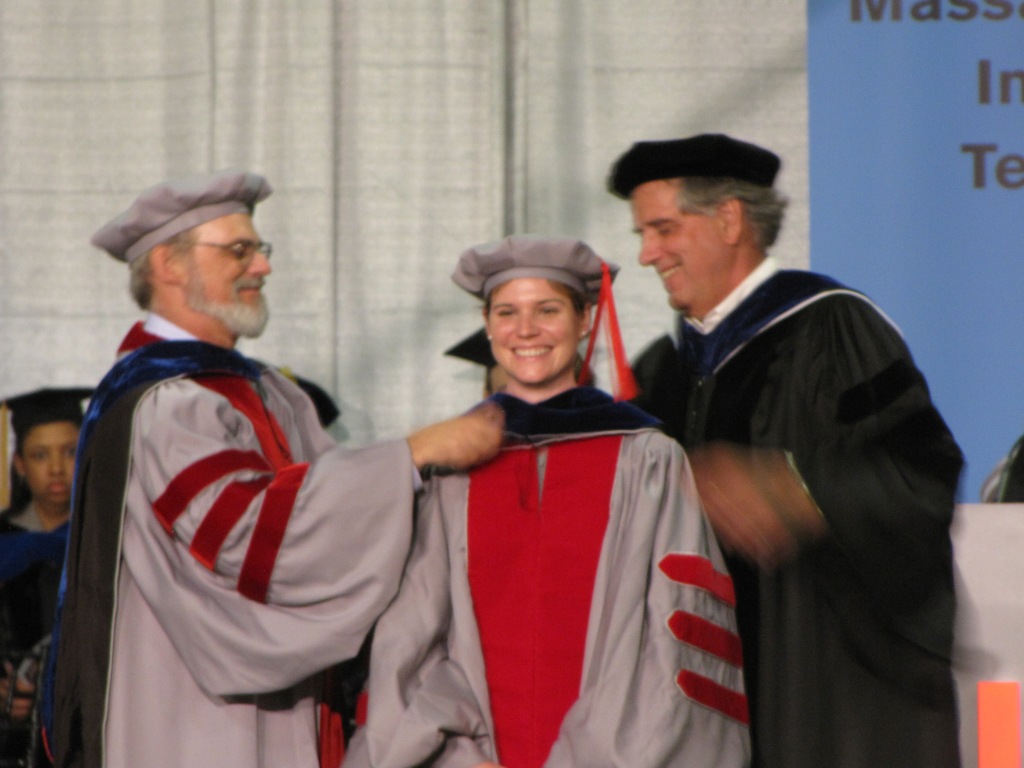
And here’s a view of the MIT/WHOI doctoral hoods from the back:

Doctoral hoods are somewhat funny garments. From what I can tell, doctoral hoods are not really designed to be worn at hoods. At least, I couldn’t figure out how to cover my head with my hood. Rather, doctoral hoods are worn on the back as a sort of decorative embellishment. The MIT doctoral hoods are black on the outside with a blue velvet strip for PhDs and a yellow velvet stripe for DScs. The inside of the hood is lined with the MIT school colors– red and gray. In addition, the hoods of MIT/WHOI doctors are lined with a stripe of “Old Glory” blue, which can be seen at the bottoms of the hoods in the above picture. The hoods contain a pocket which, as the chancellor explained during the hooding ceremony, “Is big enough for a book or perhaps a sandwich but is too small for an iPad.” Graduates were not permitted to carry purses and other bags for either the hooding or commencement ceremonies. The men generally wore pants with pockets and were able to store their wallets, keys, cell phones, etc. in their pants’ pockets. Most of the women, on the other hand, wore dresses or skirts underneath their robes and had difficulty finding places to store their things. Keys and wallets and such were stored in sleeves and blouses and even, in one case, underneath a hat. I know many women were grateful for their hood pocket for the commencement ceremony. Personally, I stored my Kindle, keys, wallet, and cell phone in my hood pocket for the commencement ceremony.
The commencement ceremony on Friday June 8th was held in Killian Court, which is a beautiful courtyard located across the street from the Charles River and adjacent to one of MIT’s classic domed buildings. Like the doctoral hooding ceremony, the commencement ceremony was fairly simple– a long, hot procession (they actually made us walk a lap around the MIT track!) followed by sitting in the courtyard and listening to a few speeches and then about two hours of name reading and diploma receiving. The day was fairly sunny and warm, and the graduates were sitting in the sun. Like many other graduates, I unbuttoned and loosened my doctoral robe, grateful that I was wearing a fairly cool sundress underneath. While name after name was called, I chatted with my classmates and read a book on my Kindle. Eventually, the time came for the MIT/WHOI graduates, and we lined up to approach the stage. My name was finally called, and I received my diploma from MIT president Susan Hockfield and WHOI president Susan Avery.
Here’s a picture of me receiving my diploma:

Here are a few more pictures from the doctoral hooding and commencement ceremonies:

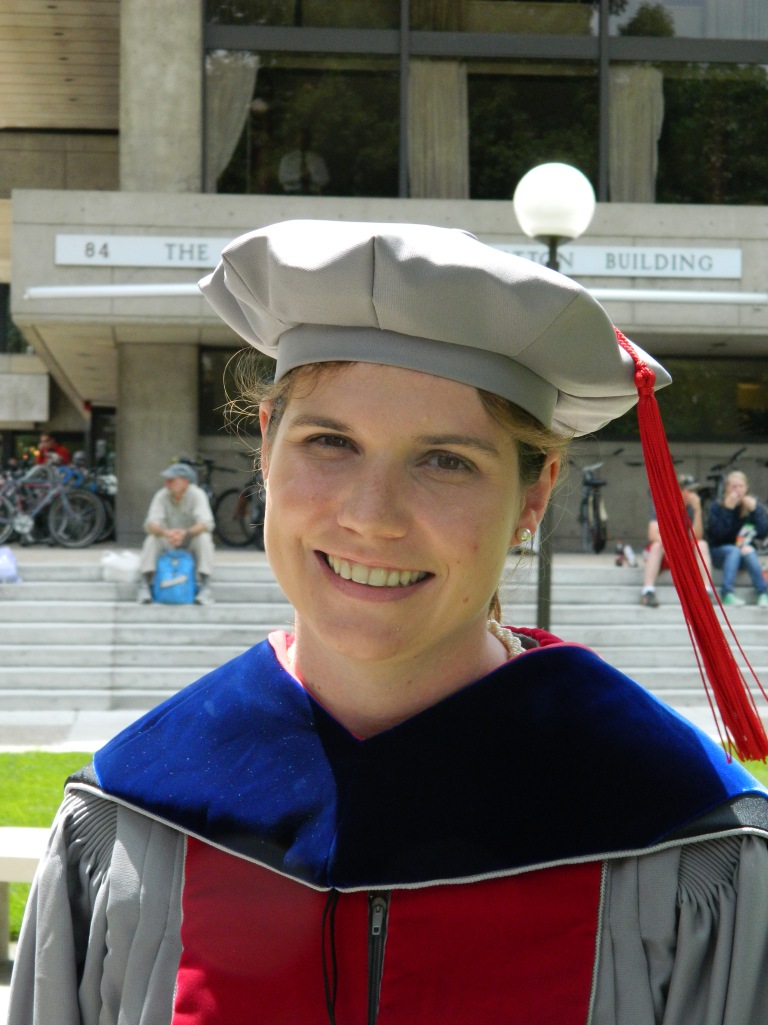


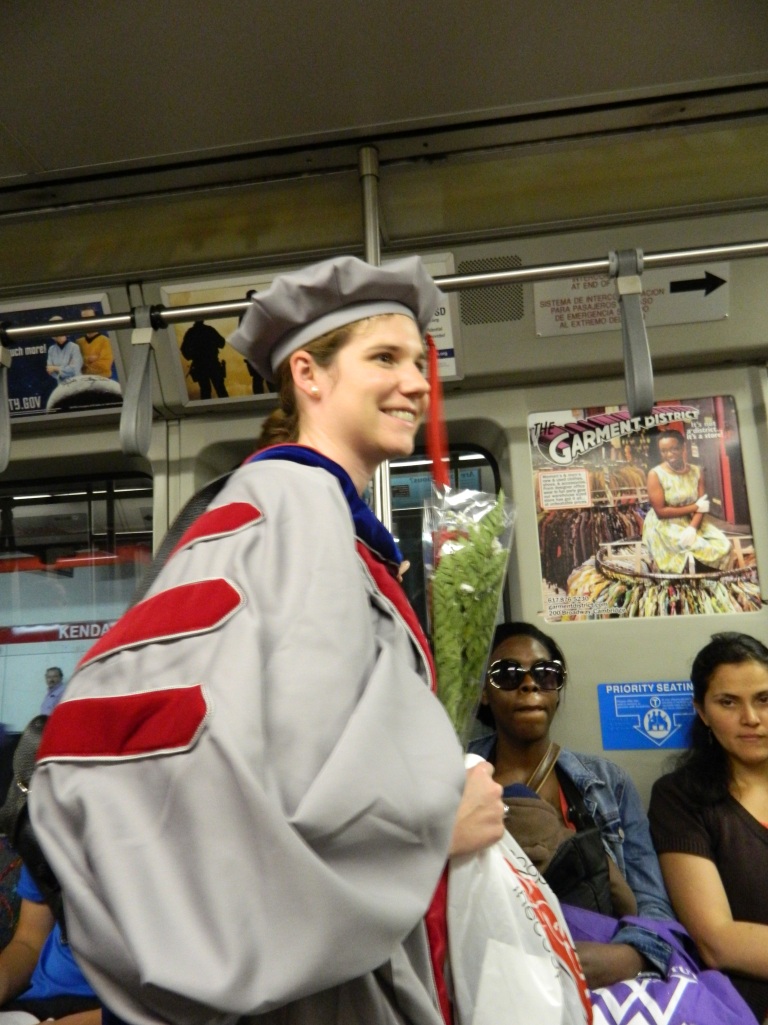

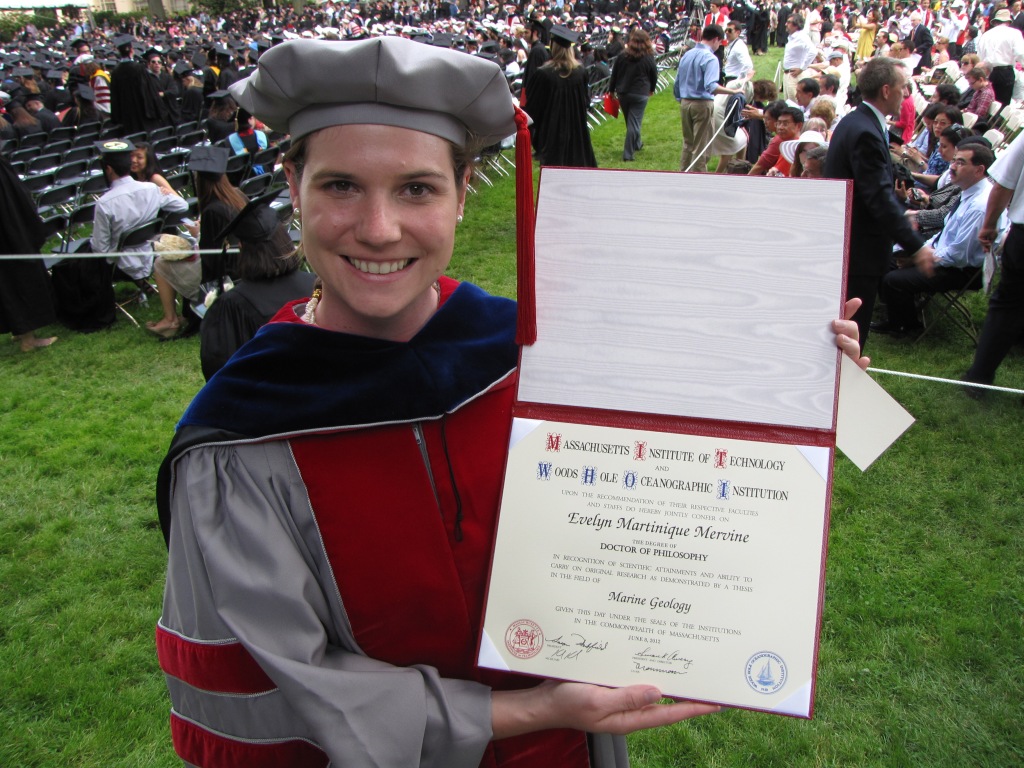

Those are the pictures I have to share. Please share some pictures of you in your own academic dress!

